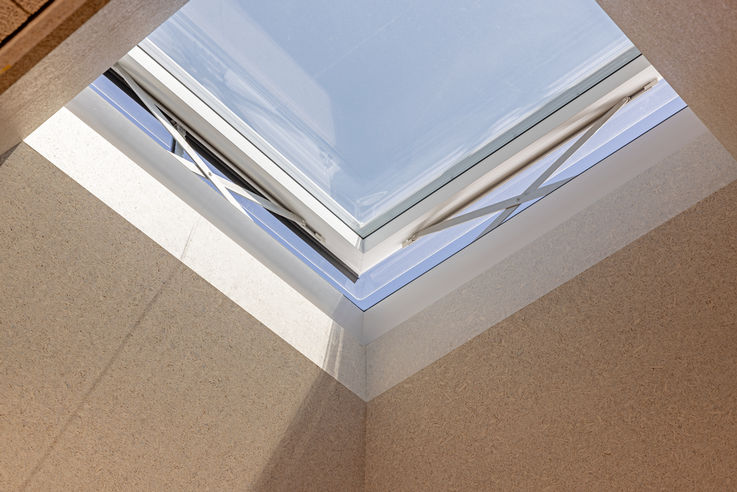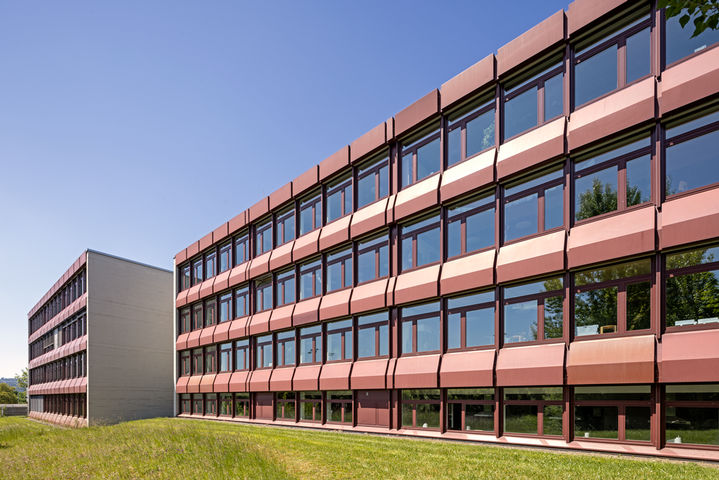Night-time cooling and natural ventilation for Swiss school
In order to make the Lindenbüel school building in Volketswil fit for the future, the windows of the school building were retrofitted with electric window drives as part of an extensive renovation. Thanks to automated natural ventilation and night-time cooling, the indoor climate has improved noticeably, and the investment has also paid off in terms of energy efficiency.
Sustainable school: improved indoor climate and reduced energy consumption
The Lindenbüel school building in Volketswil, Switzerland, needed renovations to be more resource-efficient, sustainable and comfortable in the future. One key objective was to use natural ventilation and night-time cooling to improve the indoor climate while promoting sustainable and resource-efficient building operation. The goal was to make the building fit for the future in the face of climate change. To this end, the windows needed to be equipped with electric drives and a control system needed to be installed on site.
Sustainable school renovation: Why an energy-efficient façade is essential

Fanlight in the school corridor for ventilation and as a source of light. © Lorenz Frey / GEZE GmbH
For economic and environmental reasons, buildings are being used for longer and longer periods of time. Legal requirements such as the Climate Protection Act and the European Green Deal are reinforcing this trend, as they drive renovation projects and set clear requirements for building energy efficiency. As a result, energy efficiency in existing buildings must be significantly improved.
Automated façades in particular can deliver impressive improvements in energy efficiency, comfort and safety. This does not always require the entire façade to be replaced. Often, simply retrofitting manual windows with electric window drive can significantly improve a building's energy balance.
Climate Protection Act
The Climate Protection Act stipulates that Germany should become climate neutral by 2045 at the latest and that 65 per cent of greenhouse gas emissions should be reduced by 2030. Energy-efficient renovation of existing buildings, in particular, is one potential way to meet this goal. The potential savings are huge: building operations account for around 35 per cent of final energy consumption and around 30 per cent of CO2 emissions in Germany. Similar laws have been passed in many other countries in recent years.
Retrofitting smart window drives can be carried out quickly and cost-effectively as part of a building renovation . Networked via the IQ box KNX, windows can be integrated directly into the building automation system and conveniently controlled via the building management system. There are many reasons to use this kind of retrofitting and automation, particularly in schools.
6 good reasons for natural ventilation with electric window drives via building automation
In view of changing climatic conditions, schools must find ways to make their buildings usable and comfortable in order to ensure stress-free learning and teaching. One relatively straightforward solution is to use natural ventilation in the form of an energy-efficient façade. Building automation allows classrooms and common rooms to be air-conditioned more comfortably for pupils and staff – without the use of costly and energy-intensive air conditioning units.
A good indoor climate is essential for health and learning. Electric window drives enable demand-based ventilation, often controlled by timers or sensors. In combination with CO₂, humidity and temperature sensors, air quality is continuously monitored and improved in a targeted way. This ensures that fresh air reliably enters the room, stuffy air is avoided, the risk of mould is reduced and overall room hygiene is improved. In particularly busy classrooms, teachers and pupils benefit from healthy air and improved concentration – without teachers having to intervene manually.
Automatically controlled night-time cooling is particularly beneficial during the summer months, when ventilation is less efficient during the day. The windows open in the early hours of the morning to cool the room to the optimum temperature, without added personnel expenses. Sensors simultaneously check that there is no danger from weather conditions such as strong wind or rain and, if necessary, close the windows. Teachers and students benefit from an optimally temperature-controlled classroom even before lessons begin.
Automating window operation significantly reduces the effort required for manual ventilation. This saves time and minimises the risk of operating errors, especially in large buildings with many rooms. Centrally controlled systems can ventilate entire wings of buildings simultaneously, making maintenance, control and opening processes more efficient. Neither teachers nor facility managers are responsible for opening and closing all windows in short periods of time, such as during breaks or early in the morning before school starts. This also ensures that no windows are left open unintentionally: their status can be viewed at any time, and any error messages – for example, in the case of blocked windows – are displayed automatically.
Uncontrolled or excessive ventilation leads to energy losses – especially during the heating season. Electric window drives allow ventilation intervals to be precisely controlled and adjusted to actual requirements. In combination with heat recovery systems or night cooling concepts, heating and cooling costs can be significantly reduced. In addition, windows can be closed automatically if the outside temperature deviates too much, which prevents further energy loss. This keeps children from having to sit in freezing classrooms, especially in winter, and reduces avoidable heating costs.
Electric window drives increase security . Windows can be reliably closed using central control units or timer schedules. At the same time, the windows can be secured. This allows the closing edges to be monitored with a laser scanner to prevent fingers from getting caught. The IQ box Safety safety module stops or reverses movement as soon as a foreign object is detected in the danger zone. Another advantage: the window drives can also be used for enhanced fire protection, e.g. as a smoke vent in the event of smoke. Safety is paramount, especially in educational institutions where vulnerable children are present.
Thanks to the option of operating the windows via tablet, smartphone or PC, they can also be operated manually by people with disabilities or remotely. Finally, electric drives can be integrated into smart building technology – for sustainable school architecture that is fit for the future.
Smart building automation: advantages of control via KNX

Corridor IQ box KNX HS controllers integrated into the customer's electrical installation cabinet. © Lorenz Frey / GEZE GmbH
When controlled via a KNX module, the window drive responds to commands such as "open" or "close". The KNX system, which is not installed in the drive itself, but on site – this is in a control cabinet in the Lindenbüel Volketswil school building, – is what makes the system intelligent.
Controlling the window drives via an intelligent KNX module offers a wide range of intelligent and flexible control options that can be used as needed.
- Sensor-based automation
- Time and scene control
- Central control unit
- Integration into the building management system
- Logical connections
- Integration into security and fire protection systems
Natural ventilation for the Lindenbüel school in Volketswil

The chain drive responds to commands such as open or close. © Lorenz Frey / GEZE GmbH

The successful pilot project marked the start of retrofitting all windows with the GEZE Slimchain. © Lorenz Frey / GEZE GmbH
This range of advantages – creating the best possible indoor climate for working and learning with automated natural ventilation and night cooling, while saving resources and energy costs – was why the school chose the system.
GEZE Switzerland Ltd. was chosen as the partner for the planning, products and implementation of the project: with the GEZE Slimchain chain drive, GEZE offered an ideal product for the requirements of this project. In combination with the IQ BOX KNX, they are connected to the KNX module and thus integrate seamlessly into the on-site control system. Modern building automation can be used to achieve optimal ventilation. Centrally controlled, the drives open and close the fanlights in the classrooms and corridor, contributing to a pleasant indoor climate.
Convincing measurement results: from sample windows to comprehensive retrofitting
As a first step, the client initially wanted to convert a single room. After extensive consultation, a sample window was equipped with the GEZE Slimchain chain drive and the IQ Windowdrive. Data was collected and compared over the course of one summer. Outstanding data from the pilot project then provided the basis for conversion of the entire school building. In the further course of the project, a total of 121 drives, as well as associated electrical components, were installed. This extensive work was carried out in two stages: first, some of the classrooms, doors and corridor windows were converted and put into operation. Additional classrooms were added in a further stage. Both installation and commissioning were carried out by GEZE Switzerland. To ensure trouble-free operation, thorough instructions were given to the technical service on site.
The customer is delighted with the smooth implementation of the project and the high-quality product:
Working with GEZE Switzerland AG, our customers enjoyed a comprehensive, worry-free package – from expert advice and sample windows, which delivered convincing measurement results over an entire summer, to professional installation and handover.
Nathan Grob, Commercial Technical Advisor at GEZE SwitzerlandRenovation during ongoing operations: Possible thanks to optimal project planning
Completing renovations while operations are ongoing should be considered not only in schools, but whenever a building can only be vacated for renovation at great expense. At the Swiss school, this was possible with some restrictions, and the main objective – to keep the school running – was achieved. To this end, one part of the building was cleared during each construction phase, while lessons continued in the other part. This meant that the extensive work was not limited to the short time frame of the summer holidays, but could also continue during normal school hours.
Refurbishment and modernisation during ongoing operations with GEZE
GEZE is happy to provide support for refurbishment during ongoing operations right from the start of project planning. This allows the best possible process to be organised for all parties involved – from the building operator and users to the trades involved in the renovation.
Learn more about conversion and modernisationLindenbüel School Building, Volketswil
The Lindenbüel school building was completed in 1974 and is located in the centre of the village of Volketswil. 280 pupils are taught there by around 35 teachers in 14 classes. The school building serves as the upper school building for the secondary school.



